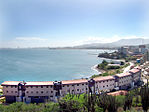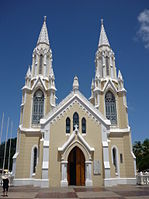Isla Margarita
|
Native name: Isla Margarita Nickname: Pearl of the Caribbean |
||||||||||
|---|---|---|---|---|---|---|---|---|---|---|
|
||||||||||
| Geography | ||||||||||
| Location | Caribbean Sea | |||||||||
| Coordinates | 10°59′13″N 63°56′08″W / 10.98694°N 63.93556°W | |||||||||
| Area | 1,020 km2 (390 sq mi) | |||||||||
| Length | 78 km (48.5 mi) | |||||||||
| Width | 20 km (12 mi) | |||||||||
| Highest elevation | 920 m (3,020 ft) | |||||||||
| Highest point | San Juan or Cerro Grande | |||||||||
| Administration | ||||||||||
|
Venezuela
|
||||||||||
| State | Nueva Esparta | |||||||||
| Largest settlement | Porlamar (pop. 85,000) | |||||||||
| Demographics | ||||||||||
| Population | 436,900 | |||||||||
| Pop. density | 411.76 /km2 (1,066.45 /sq mi) | |||||||||
Margarita Island (Isla de Margarita, Spanish pronunciation: [marɣaˈɾita]) is the largest island in the Venezuelan state of Nueva Esparta, situated off the northeastern coast of the country, in the Caribbean Sea. The capital city of Nueva Esparta, La Asunción, is located on the island. Primary industries are tourism, fishing and construction.
Christopher Columbus was the first European to arrive on Margarita Island in 1498. The local natives were the Guaiqueries people. The coast of the island was abundant in pearls, which represented almost a third of all New World tribute to the Spanish Crown. Margarita Island was fortified against the increasing threat of pirate attacks, and some fortifications remain today. It was the center of Spanish colonial Margarita Province, established in 1525.
In 1561, the island was seized by Lope de Aguirre, a notoriously violent and rebellious conquistador. Around 1675, the island was captured again, this time by Red Legs Greaves, a pirate known for his humanity and morality. He captured a fleet of Spanish ships off port, before turning the guns on the forts which he stormed and claimed a large booty of pearls and gold.
Construction of the fort Santa Rosa was ordered by the governor, Juan Muñoz de Gadea, after the French buccaneer Marquis de Maintenon attacked the island in early 1676.
The island gained independence from the Spanish in 1814 after the collapse of the First Republic of Venezuela. It became the first permanently free territory in Venezuela. In the same year, Luisa Cáceres de Arismendi was detained for over three years in a dungeon of the Fortress of Santa Rosa on the island in an attempt to put pressure on her husband Juan Bautista Arismendi, who was fighting for independence. Simón Bolívar was confirmed as Commander in Chief of the Second Republic of Venezuela on the island in 1816. From there he started a nine-year campaign to free Venezuela, Colombia, Ecuador, Peru, and Bolivia from the Spanish Crown.
...
Wikipedia









